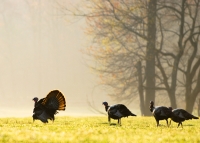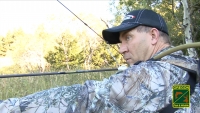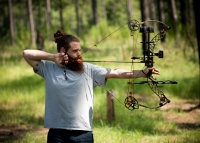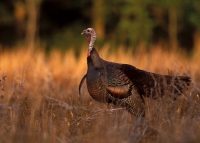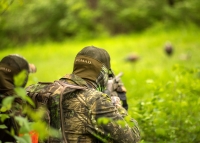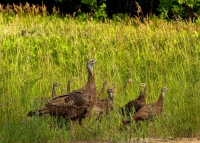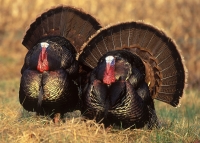
Scouting for turkeys
Scouting for turkeys
Whether you’re out the night before preparing for your morning hunt, or studying the habits of a flock throughout the year, scouting ahead of your hunt will help you find more birds during your hunt.
Use optics to spot birds
With binoculars or a spotting scope you’ll be able to spot and study birds from a distance without spooking them.
Don't be in a hurry when watching turkeys through binoculars or a spotting scope. The birds won’t know you’re there, so take time to study the hens and toms in the flock.
See if there’s a big tom you want to go after, or if there are only jakes in the flock. If birds are tucked tight beneath trees or against brush, try to figure out why. Is it heat, rain, wind, predators or some other factor that have pushed them toward a certain kind of habitat? This information might suggest a certain hunting strategy. For example, if turkeys are holding in cover, it may be better to approach and call to them from the trees, instead of trying to pull a tom across an open meadow.
Learn more with a trail camera
Some hunter like to set up trail a camera(s) once they’ve located a flock, so they can have eyes on the birds 24/7. Footage from the camera can show how many turkeys are in the area, and what their daily routine is. What time do they leave the roost, where do they go and when do they return? Trail cameras also can show what predators are in the area – information that could inform how you hunt.
If you want to learn even more about turkey behavior, set your trail camera(s) on video mode. What you see and hear can be enlightening. You’ll be amazed at how vocal turkeys are in the fall, for example. This might influence the kind of call you’ll use and how frequently you’ll use it.
Scout birds AND habitat
When scouting for turkeys, don’t limit your focus to the birds themselves. This is the time to study the habitat in which turkeys live. Learning the lay of the land, and how turkeys move upon it, will help you figure out where to set up and call on hunting day.
Cover your potential hunting ground during the middle of the day, during the off-season or whenever turkeys aren’t in an area. On a map or with a GPS, mark points of interest such as creek bottoms, game trails, old logging roads and small openings that may be potential strutting grounds.
Look for loose turkey feathers, tracks and droppings beneath roost trees. Some roost trees that have been used for decades will have a couple feet of droppings beneath them.
When scouting in the morning, look for any turkey tracks in dew-covered grass. These tracks are easy to see, and are solid indicators that turkeys are nearby, even if you don’t see or hear them.
Scouting on foot lets you see exactly where you might set up a ground blind and place decoys, and even help find the specific tree you’ll sit against if you're hunting from the ground with a shotgun.

